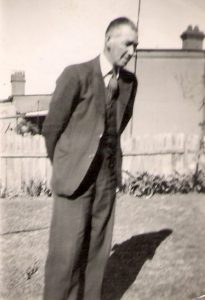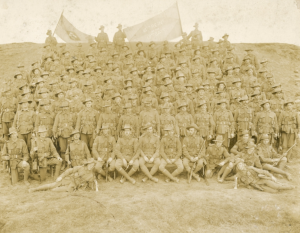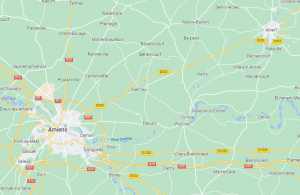10 minute read
Anzac Day, 2022. It is 104 years since Mick Quirk fought on the battlefields of the Western Front. This is the story of Mick’s war, in particular his final month, April 1918, where I have been able to trace his movements through his battalion’s unit diary. Mick was a treasured member of my father’s side of the family and many of the memories shared here come from the stories my Aunty Joyce and Uncle Bert shared.

Ernest James ‘Mick’ Quirk was my father’s paternal great uncle. Born in Sydney in 1885 to Irish Catholic parents, Mick was the eldest of five children. Mick’s childhood was marred by the economic downturn of the 1890s, resulting in his father being unable to support the family on many occasions and his mother seeking help at Sydney’s charitable institutions to survive. As a young boy Mick took up labouring, subsequently becoming head of the family aged 19 when his father died. The family lived in the then working-class suburb of Woollahra, in Sydney’s eastern suburbs, in rented terrace houses. Mick had a close circle of mates, including his two brothers Jack and Modge, his Faddy cousins and the Tidyman brothers. You can read more about these Woollahra mates and their families during WW1 here: https://quirkycharacters.com.au/stories/i-waved-him-goodbye/
Mick’s days were spent working hard to provide for his family and spending his leisure time playing cricket and football with his mates. In January 1914 however, he suffered the devastating blow of losing his mother. By now his step-father James Stanley had joined the family so between James, Mick and his brothers, the girls Mabel and Eileen were taken care of. Eileen married in April 1914, leaving just Mabel at home. But war loomed on the horizon and in August 1914, Australia declared war on Germany, initiating a chain of events that would traumatise the Quirk family. Jack, two years younger than Mick, volunteered to serve straight away and landed at Gallipoli that first fateful morning. Modge, the third brother, would follow six months later. Slowly, one by one, Mick’s family members and mates enlisted to serve in the army.
Weighed down by the responsibilities at home, Mick delayed his enlistment until November 1915, signing up together with his mate Bob Tidyman. Mick was 30 years old by now but downplayed his age to 25 years and 11 months. His enlistment records shows he was a tall man for his time, some 5ft 9 inches, as can be seen in a later photograph of him, one of only two shadowy images I hold of him. He weighed just 65 kilograms, with a 35-inch chest. He was described as having ruddy features, with blue eyes and light brown hair. He was initially assigned to the 11th Reinforcements, then bumped to the 14th Reinforcements, of the 19th Battalion. Bob was assigned to the 11th Reinforcements, then left Australia earlier than Mick, in May 1916 onboard the Megantic. Mick followed months later, embarking on the ship Wiltshire in Sydney in August 1916. On arrival in England, both men were assigned to the 5th Training Battalion, based at Fovant on the Salisbury Plains in Wiltshire, just 15 miles south of Stonehenge.

But by the time Mick had arrived, Bob had already proceeded to the front in France. Hampered by ‘a regular ocean of mud’ and ‘the coldest winter in living memory’, Bob and the rest of the 19th Battalion headed for the Somme. Bob’s war lasted only a couple of months as he went missing on the 14th November 1916 after being left in charge of 50 German prisoners. It’s believed he was felled by a sniper. His body was never recovered. Word of Bob’s disappearance would have filtered back to Mick in England, either via injured returned mates, the authorities or letters from the home front. Mick’s venture to the front had been delayed by his ill health, with him spending months in and out of hospital with a number of complaints including a sprained ankle and scabies, an intensely itchy skin condition.
But in October 1917 however, Mick was declared fit and marched back out to his original unit, the 19th Battalion. He crossed the English Channel on the 17th October 1917 and joined the Allies on the Western Front. Mick was finally reunited with his brother Modge, who had spent the past two years fighting at both Gallipoli and in France. Mick marched to where the 19th Battalion were now working on the railway line at Ypres, in Belgium. They were camped there until the 29th October, then on the 2nd November the battalion was split into two groups. A & B company, of which Mick was a part, were sent in to relieve the 26th Battalion at Anzac and Tokio Ridges. C & D Company, where Modge was assigned, was sent to Westhoek Ridge. This transition was completed during the day under heavy shelling and later that night, the Germans sent gas shells over the area.
By now winter was setting in and the hostilities took a quieter turn from December through to March. As in previous years, the damaged landscape encouraged the rain to turn the fields to mud, making for uncomfortable days and nights in the trenches. Duckboards went some way to preventing the men standing in mud but still, the conditions posed a continual threat to their feet. If left in wet socks and boots, a condition called trench foot could occur, leading to gangrene and in extreme circumstances, amputation. Soldiers’ feet were regularly inspected for the tell-tale signs of the condition, such as ulcers. The men were instructed to change their socks regularly and try to keep their feet as dry as possible. In his later years, Mick’s family could never understand why he only ever had one pair of socks. Those socks were darned to within an inch of their life, yet he refused to buy another pair until they had completely worn out their usefulness. It was whilst on the Western Front that Mick learned to be grateful for small comforts.
Mick was now entering the final month of his war experience. The 19th Battalion’s unit diary gives us a glimpse into the daily machinations of war. As the weather warmed up and the war dragged on with no resolution in sight, the Germans launched their spring offensive, named Operation Michael. By the 29th March 1918, the Germans had captured the strategic town of Albert. On the 4th & 5th April, fighting continued around Villers-Bretonneux with the British and the Australian forces repelling the Germans. On the 7th April, the 19th and 20th Battalions moved posts forward a few hundred yards to help straighten the defensive line. Mick and Modge were back in the thick of the action. It was sadly on this day that Modge lost his life at Hangard Wood, in the attack that saw his commander Lt Percy Storkey, awarded a Victoria Cross.

Despite reeling from the loss of his brother, Mick had to carry on regardless. The following day, after the disastrous events at Hangard Wood, the 19th was relieved by the 34th Battalion and whilst German shelling continued, it was otherwise quiet. The men went back to their billets in Boves. These billets were temporarily acquired lodgings that were sometimes farmhouses or barns or halls. This brought the Australians into close contact with French civilians. There was also time for a drink, a meal and some entertainment at an ‘estaminet’ or French café. By the 12th April however, the shelling had become so bad that the battalion had to move on, spending time sleeping in the open on a hillside, in their bivouacs with the only protection being a flimsy tented shelter if lucky, or just their overcoats, or tree branches if nothing else could be found. The following day the battalion was on the move again, this time to Bois de Gentelles (Bois meaning Wood) where A company, Mick’s company, relieved the 8th Royal Berkshire Regiment on the front line. It was another miserable rainy night for the whole battalion.
On the 15th April the battalion was back at Hangard Wood, relieving the 17th Battalion. Four groups of ten men each were sent out to the Wood on nightly scouting operations. The return to the Wood just a week after Modge’s death must have been traumatic for Mick, wondering where his brother lay. And amidst the constant lookout for the enemy was dealing with their constant gas shelling. For days at a time, Mick and his comrades removed their masks only to hastily pull them back over the faces as another attack occurred. On the 17th April an estimated 12,000 shells fell in the Villers-Bretonneux area. Phosgene was an irritant that was slow to act, causing problems hours and sometimes days later. Gas masks were effective at easing issues caused by this gas, if worn correctly. Even worse was to come however with the release of mustard gas. This gas could cause blisters all over the body and if inhaled in large quantities, could kill men by blistering the lungs and airways. It wasn’t enough that mother nature was against you during the colder months and the enemy was trying to kill you with bullets, you also had to be wary of the invisible gasses released from shells. Major-General A.B.E Cator of the British 58th Division spoke of the men involved in the action at this time as ‘quite one of the best fighting units I have come across.’
On the 19th April the battalion moved out of the front line and to temporary bivouacs in the Bois de Gentelles area. The evening was cold with wind squalls and light snow showers and the soldiers tried to keep warm however they could. The next morning the battalion marched from south-east of Amiens further north to Montigny via Pont-Noyelles, where a reconnaissance of the nearby village of Franvillers was conducted. The following day being a Sunday, the brigade had a church parade. That afternoon all ranks of the 19th Battalion washed away their cares at the baths at Behencourt. In the midst of war, there was still opportunity to enjoy a few simple pleasures. Two days later, on the 23rd April, the battalion was inspected by Lt General Birdwood, Commander of the Australian troops. That night they slept in billets in Warloy, having marched there via Beaucort and Contay. Whilst the battalion then spent the next three days training on the Lewis guns, the Germans made another assault on Villers-Bretonneux, gas shelling the town and eventually taking hold of it. The Allies fought back and on the 25th April, the 3rd anniversary of the Gallipoli landing, British and Australians troops took back the town in a major victory of the war. Mick was just 20 kilometres away from the scene of this infamous battle.
But it was whilst at Warloy that Mick started to feel the effects of the gassing a week prior and he, along with 61 other men, were evacuated to the 7th Australian Field Ambulance. It took several days to evacuate Mick back to Old Blighty, passing from the ambulance train to the 8th General Hospital in Rouen, then onto the hospital ship Carisbrook Castle to cross the English Channel and finally to the military hospital in Sutton Veny, back in Wiltshire. Mick would convalesce for a further six months before returning to Australia on the ship Ceramic, notably the same ship his brother Modge had taken on his forward journey to war.
Mick had come full circle. Upon his return, Mick moved in with his sister Eileen and brother-in-law Bert Poulter’s family. They all later moved to Winchester Road, Clovelly where Mick lived out the rest of his days, never marrying. War had taken his mate Bob and his brother Modge and left him with permanent physical impediments like his crook lungs but in his sister’s family he found sanctuary. Whilst the 1920s brought some prosperity, by the early 1930s, Mick and the Poulter family were living through the Great Depression. Mick’s early years and his war experiences had taught him to be frugal. There was his one pair of darned socks he held onto in addition to the one pair of sunglasses with a lens missing that he wouldn’t part with, despite his sister’s nagging. The Depression years were tough on Mick, already middle aged, and put out of work regularly as married men were favoured for the available jobs going. In 1939, all of Mick’s fears came flooding back, as Australia faced another war with Germany. His eldest nephew, Billy, enlisted and served in New Guinea but thankfully came home. As the second world war came to an end, and by now aged 60, Mick passed away and he was buried in Botany Cemetery near his second eldest nephew Mitta, who had died three years previously.
We thank Mick this Anzac Day, for his service, and we remember him. Lest we forget.
